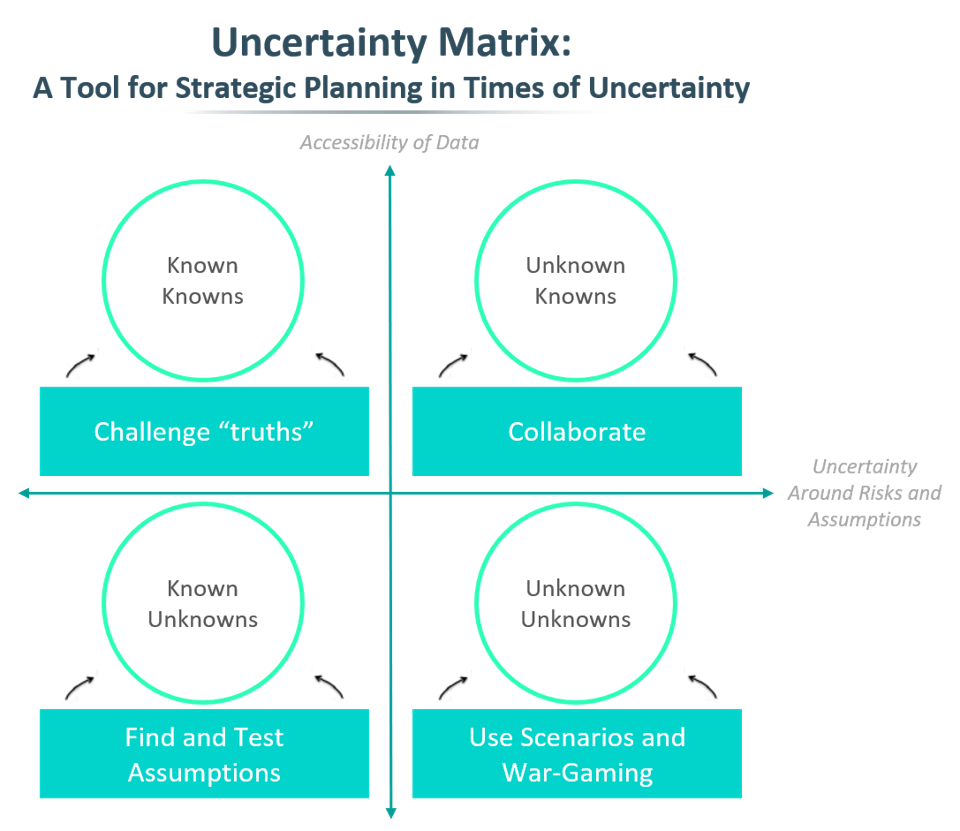More so than perhaps any year since 1945, 2021 brings both great hope and tremendous challenge. For businesses looking to turn the corner even as the worst of COVID ravages both societies and industries, it is imperative to plan for change – how to deal with the behavior shifts wrought by the crisis, how competitive dynamics have altered, and how new opportunities have opened up. It is highly unlikely that last year’s strategic plan has much validity after the crisis, but how do you create a new, timely plan with so much uncertainty still swirling?
The Uncertainty Matrix is a powerful tool to separate out facts and questions into four distinct groups, each of which should be addressed in its own manner. Through use of this tool, you can plot what is certain, devise scenarios for what is less understood, and plan targeted actions. A version of this approach has been used by the U.S. military for conflict situations, another environment known for uncertainty and rapid change.

The Uncertainty Matrix succinctly breaks an uncertain environment into four sectors.
As seen in the figure above, there are two axes: how accessible data is, and how much certainty you have around risks and assumptions. This divides knowledge into four discrete quadrants:
1. Known Knowns: What are you pretty sure about? How will that impact your strategic position and imperatives? Now, how much of what is “known” is based on historical pattern and faith rather than contemporary data? What might you pressure test? Are there big dependencies on certain factors, like regulation or rivals’ strategies, which should be called into question given how much has changed in the past year?
2. Unknown Knowns: What knowledge may lurk elsewhere in your organization that might provide real-time information on the market? What are front-line staff seeing with regard to customer behavior and support needs, for example? What might suppliers tell you about how competitors in your industry are acting? Rapid, direct interaction with people outside the normal strategic planning process might shift your assumptions and reveal new troves of timely information.
3. Known Unknowns: What are you sure you don’t know? Be comprehensive, breaking your uncertainties into fields such as economics, customer behavior, new business models, and more. Which unknowns are most important by degree of their impact, extent of uncertainty, or effect on other subsidiary issues? How can you address these in a targeted manner? While it is tempting to cut back on discretionary expenses such as market research, now is precisely the wrong time to be flying blind.
4. Unknown Unknowns: This quadrant can feel the emptiest, but it is often the most important. What factors might swamp other considerations? How might your context change in ways that upend large swathes of assumptions? Develop scenarios here, not simply using bad/middle/good cases (people always pick the middle one) but rather futures that look truly different. War-game through how you and rivals will react. Determine what really mattered, and how you need to balance having a clear vision with creating options for tactical shifts.
Armed with the knowledge from this exercise, you can then set a strategic plan with good visibility of your situation. But 2021 is not the time for an ordinary plan – extrapolation and internal focus are less important than futurecasting and making clear strategic choices. To do so, you can embrace a few key practices:
Define The Challenges: What are the critical questions you need to resolve? Importantly, how can threats and industry change be viewed as opportunities? How has the pandemic created new options for growth and new ways to do business?
Set A Vision: Your staff and customers are probably craving a clear view of where you are headed in this turbulent period. And, while nimbleness definitely has its virtues, there are some strategic shifts that require time and investment. What will your industry look like in the medium-term? Perhaps there are a couple major forks in the road, but now is the time to parse down the Uncertainty Matrix and scenario planning to a handful of key factors.
Create A Portfolio: Few Wall Street investors into an industry make just one bet. They have a portfolio that allows them to navigate uncertainties. They create options that have different timeframes for fruition and distinct levels of risk. What are yours?
Move Fast, But Not Too Fast: Speed definitely matters now, but be wary of setting plans too rapidly. Consider how many times your outlook has changed over the past several months. A strategic plan is different from a tactical plan – it needs to have durability. Staging your analysis and decisions over two to three months is typically a good way to have insight, consider various views, and proceed with perspective.
While these are unprecedented times, the discipline of planning during high uncertainty has a proven track record. These practices will create a plan that is actionable, accurate, and durable.
Contributed to Branding Strategy Insider by Stephen Wunker, Author of JOBS TO BE DONE: A Roadmap for Customer-Centered Innovation
The Blake Project Can Help You Create A Brighter Competitive Future In The Jobs To Be Done Workshop
Branding Strategy Insider is a service of The Blake Project: A strategic brand consultancy specializing in Brand Research, Brand Strategy, Brand Growth and Brand Education




